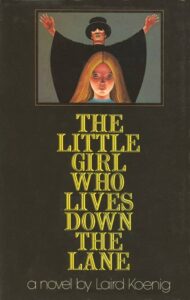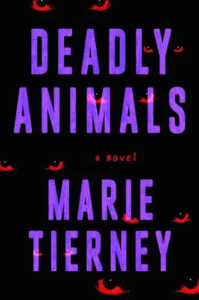Books with a strong protagonist have always attracted me as a reader, from a very early age. I learned that young characters that drive an entire story can be in adult fiction and not necessarily reserved for children’s stories. The books I have loved and continue to love with such bold characters have always been quirky and macabre, with a slightly askew moral code that always seems to know right from wrong. This list of books all feature young people who have taken responsibility for their own lives when the adults around them have abandoned or betrayed them. I think this collection suggests children are more resilient and resourceful when allowed to exercise autonomy in stressful situations.

We Have Always Lived In The Castle by Shirley Jackson
This is a mysterious tale of the Blackwood family – two sisters Constance and eighteen-year-old Merricat, and their disabled uncle Julian who live in splendid isolation in a crumbling mansion. The local villagers ostracize the Blackwoods because they still believe that the older sister Constance murdered her parents, aunt and younger brother by poisoning their dinner even though she was acquitted of the crime. Merricat wasn’t present at the fatal meal because she’d been punished for a misdemeanour and sent to bed early. Years later, witchy Merricat uses rituals and magic in a bid to protect their idyllic lifestyle which is interrupted one day by the arrival of their estranged cousin Charles, clearly looking for family treasure and a possible wife in Constance… This is an engaging story of a very macabre young girl who holds a terrible secret which, when revealed, leads to spectacular destruction.

Our Endless Numbered Days by Claire Fuller
In the summer of 1976, eight-year-old Peggy Hilcott is torn away from her peaceful life in London, kidnapped by her survivalist father James who believes that the end of the world is nigh. He takes them to a cabin in the middle of a German forest which is off-grid and miles from civilisation. For nine years, Peggy grows up learning how to survive in the wilderness while becoming increasingly lonely and her father becomes slowly insane. This is a bleak and beautifully written novel with a shocking revelation conclusion but hope is always present in the pragmatic yet imaginative Peggy.

The Girl In The Red Coat by Kate Hamer
This is a moving and unusual story of child abduction, and is told from a mother and her daughter’s point of view. Eight year-old Carmel Wakeford is lost during a local children’s festival then found by a man who claims her mother has been injured in an accident and that he is her grandfather, whom she will live with for a while. Smuggled to America, it takes Carmel months then years to realise that her new ‘family’ are not what they seem and that she has been abducted for a holy cause because the man believes that she possesses a special gift of healing the sick.
Back home, her mother desperately searches for her lost daughter all the while trying to move on with her shattered life.

The Girl Who Loved Tom Gordon by Stephen King
This is a psychological horror of nine-year-old girl Trish who is separated from her squabbling family during a forest hike and has to learn quickly how to survive on her scant provisions. All the while, she listens to a baseball game on her Walkman which features her favourite player Tom Gordon and it is through listening to the games she gains enough strength to carry on even though she is hopelessly lost, starving and becoming very ill. As the days pass, and a police search ensues, Trish often hallucinates and is sure that something evil is following her. She believes it is the God of The Lost, a confrontation with whom she is resigned to face.
I loved this book, and I appreciated Trisha’s realistic mistakes made while she comes to terms that has to survive in the wilderness.

The Machine Gunners by Robert Westall
In the fictional English coastal town of Garmouth on the eve of The Battle of Britain in 1940, fourteen-year-old Chas McGill and five of his friends strive to fight the war on their own terms. The town is regularly bombed by the Luftwaffe but one night a German plane is shot down and crashes in nearby woodland. In its wreckage, Chas finds then claims a machine gun and two-hundred rounds of ammunition. He takes it to the den he and his friends have set up, a makeshift fortress. When Chas’s house is bombed and he is presumed dead, only his friends know he is alive, and it gives them the freedom to plan and protect their town from an invasion. Nothing goes to plan and it is an unflinching adventure story that describes a realistic depiction of children teaming up for a common cause under extreme duress.

The Little Girl Who Lived Down The Lane by Laird Koenig
British girl Rynn Jacobs moves to rural Long Island with her oft spoken about but rarely seen writer father. She spends her thirteenth birthday alone – the same night as Halloween – until she is rudely interrupted by the married adult son of her landlady, Frank Hallett who is a pervert and makes a heavy pass at her but she drives him away. It becomes clear that she spends most of her life alone but never lonely, home-schooling herself. She lives off travellers cheques from a joint bank account she has with her father who is away attending book events. One day, her landlady, Mrs Hallett, barges in on Rynn’s insular world and what follows is quiet homicide, which Rynn deals with in her usual calm and calculated fashion.
Rynn has made an ally in a local policeman and his young nephew, Mario, who is an amateur magician who performs at events for the town’s rich kids. After initially mistrusting him, Rynn and Mario become good friends, spending time together, reminding Rynn she is a teenager. Their happiness is ruined when Frank turns up one evening demanding to know where his mother is, while mocking Mario’s disability, torturing her pet rat and again making sexual advances toward Rynn. Mario protects Rynn, driving Frank away. Rynn then confesses that she has not only murdered Frank’s busy-body mother but her own abusive mother whom she’d poisoned with potassium cyanide as instructed by her father who had committed suicide with the substance months earlier after contracting a terminal illness. Rynn’s mother had tracked her down so Rynn poisoned her tea, and hid her body in the basement with Mrs Hallet’s corpse. In the rain, Frank helps Rynn bury the bodies and contracts pneumonia, almost dying in hospital. Bereft, Rynn, returns home to find Frank waiting for her. He has discovered her secrets and threatens to tell if she does not let him rape her. She pretends to agree but she will make tea first. The book ends with him experiencing a coughing fit, indicating she has poisoned him too to ensure the sanctity of her safety and lifestyle.
It’s a short and brilliantly composed thriller which also raises the debate about children’s rights and autonomy.

Snap by Belinda Bauer
On a hot summer’s day, eleven-year-old Jack and his two younger sisters sit in their broken down car on the side of a busy road, waiting for their mother to return from calling for help. But she never comes back. The children’s lives are changed forever. Three years later, Jack is supporting his family alone after his father abandoned them, stealing from houses he burgles and selling the objects on to put food on the table. All the while, and keep away from the authorities so that he can keep his family together and, for a long time, succeeds. He explicably stumbles across evidence of what really happened to his mother that day, and Jack must become detective as well as protector.
Jack is a well-rendered mix of Oliver Twist and The Artful Dodger, and Bauer realistically portrays what happens to children who disappear below adult sightlines.
***


















